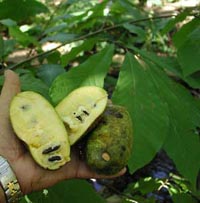Resource Library
Plant of the Week: Pawpaw
The University of Arkansas System Division of Agriculture does not promote, support or recommend plants featured in "Plant of the Week." Please consult your local Extension office for plants suitable for your region.
Plant of the Week
Pawpaw
Latin: Asimina triloba

The interplay between people and plants is a common theme in these columns, and I’m always on the lookout for anomalies in that area. One that I find difficult to explain is the wealth of material on pawpaws on the Internet.
From the numerous sites and articles published on the Internet, you would think this native tree would be everywhere. But pawpaw remains elusive. It’s seldom met with in gardens, few nurseries offer it for sale, and the fruit are almost never met with in commerce. What gives?
Pawpaw (Amsonia triloba), an understory tree usually growing 10 to 15 feet tall, is unusual in that it’s a cold hardy plant belonging to the tropical custard apple family. It ranges as far north as the Great Lakes and westward to the prairies. In the South, it mainly sticks to higher ground, avoiding the winter-wet gulf coastal plains region.
As the song tells us, pawpaws usually occur in patches, with the plants originating from suckers from an underground root system.
It has foot-long, gracefully arching, lance-shaped leaves that turn a beautiful butter yellow as fall approaches. It has among the best fall color of all trees that can grow in the woodland understory.
Pawpaw flowers are unusual, downward-facing, three-petaled affairs that appear in mid-April just as the terminal leaves begin to expand.
The fruit, sometimes called "Ozark bananas," are oval in outline and the size and shape of your average hand grenade. When ripe, they have a soft texture and a fruity flavor reminiscent of pineapple, banana and papaya. The fruit skin starts off light green, turning blackened and ugly as it ripens. The seeds are usually as large as lima beans.
Pawpaw was first described by a Portuguese adventurer traveling with Hernando de Soto as the army of 600 men explored the southeastern states from 1539 to 1542.
For the next 200 years, little is heard of pawpaw until it was described by Mark Catesby in a history book. He included a full-sized painting of pawpaw.
In his 1898 book, The Evolution of our Native Fruit, horticulturist L. H. Bailey only devotes a half page to pawpaw, speculating it has little potential as a fruit crop but may have potential as an ornamental. But a Yankee probably can’t be trusted to evaluate the worthiness of what is essentially a southern plant, so for at least a century, people have been attempting to commercialize the crop.
The most recent pawpaw revival began about 1990 in Kentucky. Since then, pawpaw Web sites have flourished. Improved cultivars have been named and are offered by specialty growers. But pawpaw plantings remain scarce, and the fruit remains the equivalent of wild mushrooms, a rare and cherished commodity amongst fanciers.
As a fruit, pawpaws have a fatal flaw. To taste good, they must be fully ripe. At that time, they have the texture of a thick pudding. Once fully ripe, they turn black at the slightest provocation. They can be stored for a week or more under refrigeration, but this completes the blackening process, and the fruit takes on a decidedly unappetizing appearance.
Pawpaws are best grown in fertile soils that can be watered during dry periods of the summer. They can grow in full sun, where their growth form changes and they take on a pyramidal habit with leaves layered like shingles on a roof. Sun-grown plants are usually taller, reaching 20 feet or more in height. For good fruit set, two clones are required to ensure cross pollination.
By: Gerald Klingaman, retired
Extension Horticulturist - Ornamentals
Extension News - October 28, 2005
The University of Arkansas System Division of Agriculture does not maintain lists of retail outlets where these plants can be purchased. Please check your local nursery or other retail outlets to ask about the availability of these plants for your growing area.